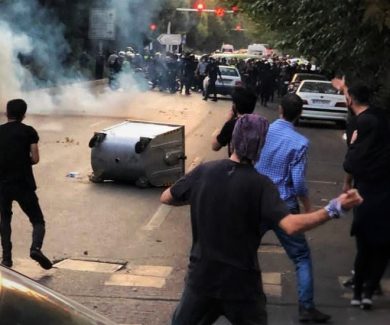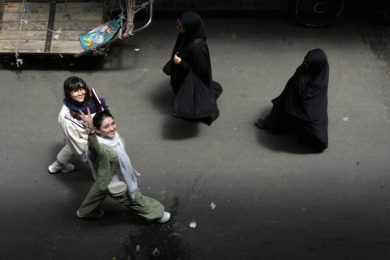In an era where digital tools shape political movements, Iranian women have turned social media into a battleground for their fight against oppression. The Islamic Revolutionary Guard Corps (IRGC), which enforces state control and censorship, has attempted to silence dissent through internet blackouts, surveillance, and arrests. Yet, Iranian women persist, using social media platforms as weapons of resistance, amplifying their voices, exposing injustices, and mobilizing for change.
From viral hashtags like #WomenLifeFreedom to encrypted messaging apps for organizing protests, digital resistance has become a crucial tool in Iran’s ongoing fight for freedom. This article explores:
• How Iranian women leverage social media to challenge the regime.
• The IRGC’s digital repression tactics.
• The role of global solidarity in supporting Iranian digital activists.
• How the world can help protect their online fight for freedom.
1. The Role of Social Media in Iran’s Women-Led Resistance
A. Social Media as a Tool for Truth and Protest
The Iranian government controls traditional media, ensuring that state propaganda dominates television, newspapers, and radio. This leaves social media as the only unfiltered space where women can expose oppression, share real-time updates, and mobilize protests.
Key Roles Social Media Plays in Resistance:
✔ Exposing human rights abuses: Videos and images document police brutality, IRGC crackdowns, and protest arrests.
✔ Breaking state censorship: Bypassing official media allows Iranians to show the world the truth.
✔ Organizing protests: Encrypted messaging apps like Telegram and Signal are used to coordinate demonstrations.
✔ Spreading awareness globally: Hashtags like #MahsaAmini, #WomenLifeFreedom, and #StopIRGC keep the Iranian struggle in the international spotlight.
Example:
When Mahsa Amini, a 22-year-old woman, was killed by Iran’s morality police for “improper hijab,” social media ignited the largest protests Iran had seen in decades. Videos of women burning hijabs, cutting their hair, and marching in the streets spread globally, forcing world leaders to acknowledge the movement.
B. Women-Led Digital Campaigns
Iranian women are leading digital resistance through powerful social media campaigns that challenge the regime’s gender apartheid.
1. #MyStealthyFreedom
• Founded by Masih Alinejad, an exiled Iranian journalist.
• Encouraged women to share hijab-free photos, defying Iran’s forced veiling laws.
• Became one of the first digital feminist movements challenging Iran’s compulsory hijab laws.
2. #WhiteWednesdays
• A campaign where women wore white headscarves or removed their hijabs every Wednesday.
• Aimed to normalize hijab resistance and encourage silent civil disobedience.
• The IRGC arrested many women participating, yet the campaign gained international attention.
3. #WomenLifeFreedom
• Became the slogan of Iran’s feminist revolution after Mahsa Amini’s death.
• Millions worldwide used it to demand justice and highlight state violence.
• Forced international governments and media to address Iran’s human rights violations.
Through these digital movements, Iranian women continue to defy the IRGC, showing that resistance is not just in the streets—it’s online too.
2. The IRGC’s Digital Repression Tactics
While Iranian women use social media to resist, the IRGC fights back with censorship, surveillance, and cyber attacks.
A. Internet Blackouts & Digital Control
During major protests, the IRGC shuts down the internet to stop activists from sharing real-time videos.
• Example: After Mahsa Amini’s death, Iran restricted access to WhatsApp, Instagram, and Telegram to prevent protest coordination.
• Government-backed cyber units monitor online activities, leading to arrests of activists for sharing protest content.
B. Online Harassment and Threats
• Women activists and journalists receive death threats, cyberbullying, and hacked accounts.
• The IRGC uses fake profiles to spread misinformation and defame activists.
C. AI Surveillance and Facial Recognition
• The government uses AI-powered surveillance cameras to track unveiled women in public spaces.
• Women identified online or in public face arrests, torture, and long prison sentences.
3. How Iranian Women Are Outsmarting Digital Censorship
Despite severe digital repression, Iranian women continue to resist online, finding innovative ways to bypass censorship and stay connected.
A. VPNs and Encrypted Communication
✔ VPNs (Virtual Private Networks): Help Iranians access blocked platforms like Twitter, Telegram, and Instagram.
✔ Signal & Telegram: Encrypted messaging apps used to organize protests without government surveillance.
✔ Satellite Internet (e.g., Starlink): Some activists rely on satellite internet to avoid IRGC blackouts.
B. Digital Safe Havens & Exiled Media
✔ Exiled Iranian journalists like Masih Alinejad and Iran International TV serve as information lifelines, reporting on Iran from abroad.
✔ Diaspora communities amplify Iranian voices by reposting protest videos and news on Western social media.
✔ Hacktivists and cyber activists target IRGC websites and propaganda platforms, disrupting their digital control.
4. The Role of Global Solidarity in Supporting Digital Resistance
The world has a responsibility to support Iranian women’s digital fight for freedom.
A. Governments Must Act
✔ Sanctions on the IRGC’s cyber units to weaken digital oppression.
✔ Pressure on tech companies to prevent Iran’s regime from using AI surveillance tools.
✔ Provide safe communication tools for activists inside Iran.
B. Tech Companies Must Support Iranian Users
✔ Ensure VPNs and encrypted apps remain available in Iran.
✔ Expand access to uncensored internet, like Elon Musk’s Starlink program.
✔ Stop Iranian government-backed disinformation campaigns on platforms like Twitter, Instagram, and Facebook.
C. Global Citizens Can Amplify Iranian Voices
✔ Share #WomenLifeFreedom and other protest hashtags.
✔ Follow and support Iranian activists on social media.
✔ Call on governments to protect Iranian women’s digital freedom.
Silence enables oppression—global voices keep Iranian resistance alive.
Conclusion: Social Media as a Battlefield for Freedom
The IRGC fears Iranian women’s digital power because it exposes the truth, rallies global support, and weakens state control. From viral hashtags to underground protest coordination, Iranian women are proving that resistance doesn’t need weapons—it needs WiFi.
Despite surveillance, arrests, and online crackdowns, Iranian women’s digital resistance continues, showing the world that no regime can fully silence a movement fueled by truth and courage.
Join Our Newsletter!
Stay informed with the latest updates, news, and ways to take action in the fight for justice and global security. Sign up now to get updates delivered straight to your inbox!





